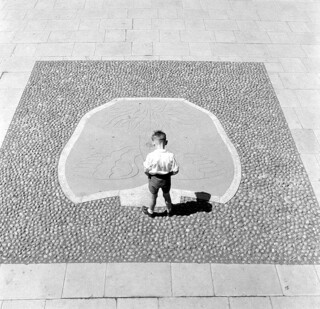Going to Coventry
Gillian Darley
When Coventry City Council applied to be the UK City of Culture 2021, and won, what on earth were they planning to do with the city centre? As Owen Hatherley has written, ‘of all of the great reconstruction projects of the first decade after 1945, there’s only one city that never seems to take possession of and pride in what it did: Coventry.’
Only two buildings, the Belgrade Theatre, the first publicly funded theatre in the country (1955-58), discreetly refurbished in the years of Arts Council lottery largesse, and Basil Spence’s cathedral, are apparently still in favour. Not so the crisply modernist (listed) railway station (1958-62), now threatened by a bulky extension and alterations. And the city centre, a much admired set-piece of postwar planning, complete with high quality public art and landscaping, is under scattergun attack, facing piecemeal destruction.
In the early 1950s, the councillors were taken to Rotterdam to admire a rebuilt city that had been as badly bombed in 1940 as their own. An exhibition and a brochure from 1945, ‘The Coventry of the Future’, had already helped them imagine what might be possible. (Archive photographs in Ida Jager’s book about Evert and Herman Kraaijvanger, the brothers who designedmuch of postwar Rotterdam, show what the councillors would have seen in the Netherlands.)
From such European models, the architect-planners, led by Donald Gibson and his successor Arthur Ling, developed a plan for the devastated fabric of their bombed-out city, and then more plans (six in all). Key areas were the Upper Precinct, Broadgate, the Civic Centre and the remarkable drum-shaped, top-lit City Market: a sequence of unassertive buildings with careful, distinctive detail, set in wider surroundings of paving, seating and public art. Trevor Tennant, responsible for much of the art, started work in 1946 with the Levelling Stone, the figure of a phoenix carved in Westmorland green slate: its purpose was practical as well as symbolic, to mark the theodolite point for the rebuilding of the city centre. No building took place until 1953, but the thinking went on.
As Jeremy and Caroline Gould make plain in Coventry: The Making of a Modern City 1939-73, Coventry’s architectural importance is immense. But the council seems not to have noticed that, or how fast life is changing around them, now that even government advice is for existing buildings to be retrofitted, rather than razed to the ground for a retail cloud cuckoo land of malls and chain stores.
The centre of postwar Coventry was designed to be legible and pleasurable, planned more gently and less rigidly than the modernist norm. As built (and embellished), it encourages people to linger, to walk through and around public spaces, offering choice rather than dictating a single unwavering route. This was a version of new architecture with a human face, so-called Scandinavian modernism; and so, without much alteration, it remains. For now.
Coventry is currently being bumped around between the demands of the university – which proposes a six-storey urban campus and, squashed alongside, a truncated portion of the former Civic Centre – and those of an increasingly impatient developer, the Shearer Property Group. Their outline application envisages a ‘dynamic new mix’, which is to say the usual city centre sponge cake: lots of shops, sprinkled with ‘leisure options’ and a few ‘places to live’. Grace Etherington, until recently a senior caseworker at the 20th-Century Society, predicts that ‘key components of the story of modern Coventry will not be standing by next year.’
A conservation officer who objected to the university’s plans left the council two years ago. At the same time, a councillor complained on his blog about ‘Historic England, an unaccountable Quango made up of non Coventrians dressed in tweeds and Rupert trousers’, listing too many buildings. The chipping away has begun, starting with the unlisted Bull Yard. The cheerful progression of small, canopied shops, stepping down to meet the Three Tuns, ornamented with heavy concrete reliefs by William Mitchell, is being demolished. Not even the glorious (listed) City Market is entirely safe, though its public art includes murals from Dresden and (relocated) ceramics by Gordon Cullen. In its everyday, rich vitality, Coventry market, when I saw it under normal conditions a year ago, teeming with business and life, couldn’t be bettered.
When I was at school being ‘sent to Coventry’ meant being ostracised by one’s sneering little peers. Now the council seems to be doing that to itself, as if driven by a masochistic impulse when faced with the reality of a permanently closed Ikea, and no department store to be the lead tenant in its proposed new city centre.
It seems to me that Coventry 2021 is ideally positioned to go in quite another direction, away from the shadow of the pandemic and towards a different kind of city centre, more like the one it began with in the immediate postwar years: modest, sustainable and responsive to reality. By respectfully upgrading its best buildings and rejecting a series of intransigent development options, Coventry could be the first of a new kind of UK City of Culture. But there isn’t much time.

Comments
I remember some Business Studies students at the old Lanchester Poly who lived in a terraced house so run-down they put up a sign for the house "Seaview". Someone sent a postcard to "Seaview, Coventry" and it got there.
Mainly, though, I remember going to the rehearsal of Duke Ellington's "Sacred Concert" in the cathedral. We have some of the mediaeval glass from the old cathedral - people just went and picked it up, my mother's family had a stained-glass artist there who did just that.
No-one cared then, but for different reasons.